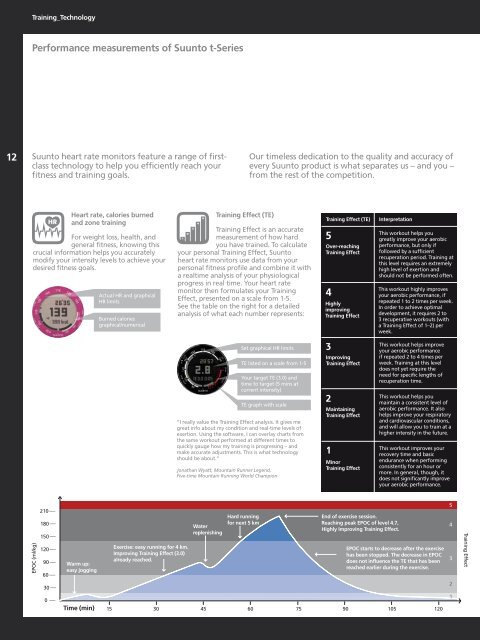SUUNTO COLLECTION 2010
SUUNTO COLLECTION 2010
SUUNTO COLLECTION 2010
Create successful ePaper yourself
Turn your PDF publications into a flip-book with our unique Google optimized e-Paper software.
12<br />
Training_Technology<br />
Performance measurements of Suunto t-Series<br />
Suunto heart rate monitors feature a range of firstclass<br />
technology to help you efficiently reach your<br />
fitness and training goals.<br />
Heart rate, calories burned<br />
and zone training<br />
For weight loss, health, and<br />
general fitness, knowing this<br />
crucial information helps you accurately<br />
modify your intensity levels to achieve your<br />
desired fitness goals.<br />
EPOC (ml/kg)<br />
210<br />
180<br />
150<br />
120<br />
90<br />
60<br />
30<br />
0<br />
Warm up:<br />
easy jogging<br />
Time (min)<br />
Actual HR and graphical<br />
HR limits<br />
Burned calories<br />
graphical/numerical<br />
Exercise: easy running for 4 km.<br />
Improving Training Effect (3.0)<br />
already reached.<br />
Training Effect (TE)<br />
Training Effect is an accurate<br />
measurement of how hard<br />
you have trained. To calculate<br />
your personal Training Effect, Suunto<br />
heart rate monitors use data from your<br />
personal fitness profile and combine it with<br />
a realtime analysis of your physiological<br />
progress in real time. Your heart rate<br />
monitor then formulates your Training<br />
Effect, presented on a scale from 1-5.<br />
See the table on the right for a detailed<br />
analysis of what each number represents:<br />
Set graphical HR limits<br />
TE listed on a scale from 1-5<br />
Your target TE (3.0) and<br />
time to target (5 mins at<br />
current intensity)<br />
TE graph with scale<br />
“I really value the Training Effect analysis. It gives me<br />
great info about my condition and real-time levels of<br />
exertion. Using the software, I can overlay charts from<br />
the same workout performed at different times to<br />
quickly gauge how my training is progressing – and<br />
make accurate adjustments. This is what technology<br />
should be about.”<br />
Jonathan Wyatt, Mountain Runner Legend,<br />
Five-time Mountain Running World Champion<br />
Water<br />
replenishing<br />
Hard running<br />
for next 5 km<br />
Our timeless dedication to the quality and accuracy of<br />
every Suunto product is what separates us – and you –<br />
from the rest of the competition.<br />
Training Effect (TE) Interpretation<br />
5<br />
Over-reaching<br />
Training Effect<br />
4<br />
Highly<br />
improving<br />
Training Effect<br />
3<br />
Improving<br />
Training Effect<br />
2<br />
Maintaining<br />
Training Effect<br />
1<br />
Minor<br />
Training Effect<br />
End of exercise session.<br />
Reaching peak EPOC of level 4.7,<br />
Highly Improving Training Effect.<br />
This workout helps you<br />
greatly improve your aerobic<br />
performance, but only if<br />
followed by a sufficient<br />
recuperation period. Training at<br />
this level requires an extremely<br />
high level of exertion and<br />
should not be performed often.<br />
This workout highly improves<br />
your aerobic performance, if<br />
repeated 1 to 2 times per week.<br />
In order to achieve optimal<br />
development, it requires 2 to<br />
3 recuperative workouts (with<br />
a Training Effect of 1–2) per<br />
week.<br />
This workout helps improve<br />
your aerobic performance<br />
if repeated 2 to 4 times per<br />
week. Training at this level<br />
does not yet require the<br />
need for specific lengths of<br />
recuperation time.<br />
This workout helps you<br />
maintain a consistent level of<br />
aerobic performance. It also<br />
helps improve your respiratory<br />
and cardiovascular conditions,<br />
and will allow you to train at a<br />
higher intensity in the future.<br />
This workout improves your<br />
recovery time and basic<br />
endurance when performing<br />
consistently for an hour or<br />
more. In general, though, it<br />
does not significantly improve<br />
your aerobic performance.<br />
EPOC starts to decrease after the exercise<br />
has been stopped. The decrease in EPOC<br />
does not influence the TE that has been<br />
reached earlier during the exercise.<br />
15 30 45 60 75 90 105 120<br />
5<br />
4<br />
3<br />
2<br />
1<br />
Training Effect


